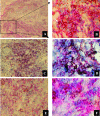The B7-H1 (PD-L1) T lymphocyte-inhibitory molecule is expressed in breast cancer patients with infiltrating ductal carcinoma: correlation with important high-risk prognostic factors
- PMID: 16611412
- PMCID: PMC1578520
- DOI: 10.1593/neo.05733
The B7-H1 (PD-L1) T lymphocyte-inhibitory molecule is expressed in breast cancer patients with infiltrating ductal carcinoma: correlation with important high-risk prognostic factors
Abstract
B7-H1 molecule increases the apoptosis of tumor-reactive T lymphocytes and reduces their immunogenicity. Breast cancer is the second most common cause of mortality after lung cancer. Direct evidence linking B7-H1 with cancer has been shown in several malignancies; however, its expression in breast cancer has not been investigated. We used immunohistochemistry to investigate the expression of the B7-H1 molecule in 44 breast cancer specimens and to study its correlation with patients' clinicopathological parameters. The expression of B7-H1 was shown in 22 of 44 patients and was not restricted to the tumor epithelium (15 of 44, 34% in tumor cells), but was also expressed by tumor-infiltrating lymphocytes (TIL; 18 of 44, 41%). Interestingly, intratumor expression of B7-H1 was significantly associated with histologic grade III-negative (P = .012), estrogen receptor-negative (P = .036), and progesterone receptor-negative (P = .040) patients. In addition, the expression of B7-H1 in TIL was associated with large tumor size (P = .042), histologic grade III (P = .015), positivity of Her2/neu status (P = .019), and severe tumor lymphocyte infiltration (P = .001). Taken together, these data suggest that B7-H1 may be an important risk factor in breast cancer patients and may represent a potential immunotherapeutic target using monoclonal antibody against the B7-H1 molecule.
Figures


References
-
- Jemal A, Tiwari RC, Murray T, Ghafoor A, Samuels A, Ward E, Feuer EJ, Thun MJ. Cancer statistics, 2004. CA Cancer J Clin. 2004;54:8–29. - PubMed
-
- Cianfrocca M, Goldstein LJ. Prognostic and predictive factors in early-stage breast cancer. Oncologist. 2004;9:606–616. - PubMed
-
- Ezzat AA, Ibrahim EM, Raja MA, Al-Sobhi S, Rostom A, Stuart RK. Locally advanced breast cancer in Saudi Arabia: high frequency of stage III in a young population. Med Oncol. 1999;16:95–103. - PubMed
-
- Ibrahim EM, al-Mulhim FA, al-Amri A, al-Muhanna FA, Ezzat AA, Stuart RK, Ajarim D. Breast cancer in the eastern province of Saudi Arabia. Med Oncol. 1998;15:241–247. - PubMed
-
- Dermime S, Armstrong A, Hawkins RE, Stern PL. Cancer vaccines and immunotherapy. Br Med Bull. 2002:149–162. - PubMed
Publication types
MeSH terms
Substances
LinkOut - more resources
Full Text Sources
Other Literature Sources
Medical
Research Materials
Miscellaneous
